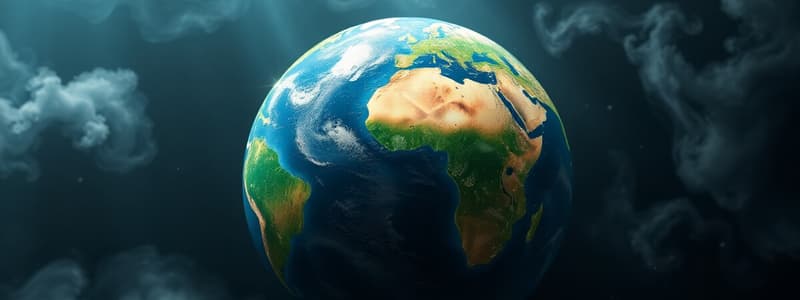Podcast
Questions and Answers
Which gases were most likely dominant in Earth's atmosphere billions of years ago?
Which gases were most likely dominant in Earth's atmosphere billions of years ago?
- Mainly composed of oxygen, water vapor, and argon.
- A mixture of argon and water vapor, with minimal nitrogen.
- Primarily oxygen and nitrogen, with trace amounts of carbon dioxide.
- Rich in carbon dioxide, nitrogen, and water vapor. (correct)
What primary process facilitated the reduction of excessive carbon dioxide levels in Earth's ancient atmosphere?
What primary process facilitated the reduction of excessive carbon dioxide levels in Earth's ancient atmosphere?
- The process of carbon dioxide dissolving in water and forming compounds like limestone. (correct)
- A decrease in global temperatures causing carbon dioxide to freeze and precipitate out.
- The absorption of carbon dioxide by early animals for respiration.
- Increased volcanic activity releasing other gases to neutralize carbon dioxide.
What was the crucial role of photosynthetic plants in the evolution of Earth's atmosphere?
What was the crucial role of photosynthetic plants in the evolution of Earth's atmosphere?
- They consumed nitrogen and released carbon dioxide, leading to a nitrogen-rich atmosphere.
- They absorbed carbon dioxide and released oxygen, significantly increasing atmospheric oxygen levels. (correct)
- They broke down water vapor into hydrogen and oxygen, increasing water vapor content.
- They absorbed oxygen and released carbon dioxide, diminishing oxygen levels.
Excluding water vapor and pollutants, which set of gases comprises the largest percentage of modern Earth's atmosphere?
Excluding water vapor and pollutants, which set of gases comprises the largest percentage of modern Earth's atmosphere?
Approximately where is half of the Earth's atmospheric air concentrated?
Approximately where is half of the Earth's atmospheric air concentrated?
What is the primary function of the ozone layer?
What is the primary function of the ozone layer?
How does human activity contribute to the destruction of the ozone layer?
How does human activity contribute to the destruction of the ozone layer?
Which statement about carbon dioxide (CO2) and global warming is correct?
Which statement about carbon dioxide (CO2) and global warming is correct?
What is one effect of increased UV radiation on Earth due to ozone depletion?
What is one effect of increased UV radiation on Earth due to ozone depletion?
What evidence challenges the claim that current global warming is part of a natural cycle?
What evidence challenges the claim that current global warming is part of a natural cycle?
Flashcards
Photosynthesis
Photosynthesis
The process by which plants use sunlight to convert carbon dioxide and water into energy, releasing oxygen as a byproduct.
Earth's Atmosphere
Earth's Atmosphere
The layer of gases surrounding the Earth, protecting us from harmful radiation and allowing life to exist.
Carbon Dioxide (CO2)
Carbon Dioxide (CO2)
A component of the Earth's early atmosphere that was released from volcanoes. It has significantly decreased over time due to absorption by oceans and formation of limestone.
Outgassing
Outgassing
Signup and view all the flashcards
Nitrogen (N2)
Nitrogen (N2)
Signup and view all the flashcards
Ozone Layer
Ozone Layer
Signup and view all the flashcards
Greenhouse Effect
Greenhouse Effect
Signup and view all the flashcards
Global Warming
Global Warming
Signup and view all the flashcards
Ozone Depleting Substances
Ozone Depleting Substances
Signup and view all the flashcards
Human Pollution
Human Pollution
Signup and view all the flashcards
Study Notes
Earth's Early Atmosphere
- Billions of years ago, Earth's atmosphere was primarily carbon dioxide, nitrogen, and water vapor, released by volcanoes.
- Carbon dioxide dissolved in water and reacted with calcium to form limestone, reducing atmospheric CO2 levels.
- Photosynthetic plants evolved and produced oxygen faster than it was removed, significantly altering the atmosphere.
Role of Life in Atmospheric Evolution
- Oxygen levels increased due to life processes, notably photosynthesis.
- Most life doesn't require oxygen, but current atmospheric oxygen levels are primarily a result of biological activity.
Modern Atmosphere Composition
- Earth's current atmosphere is approximately 78% nitrogen, 21% oxygen, and 1% other gases (like argon and carbon dioxide).
- Other components include water vapor, dust, pollutants, and microbes.
- A significant portion of the atmosphere (about half) is within the first four miles above Earth's surface.
Atmosphere Mass and Retention
- The total mass of Earth's atmosphere is 5,000 trillion tons, which is a tiny fraction of Earth's overall mass.
- Earth's gravity prevents the atmosphere from escaping into space, although some atoms do escape.
Ozone Layer Formation and Function
- An ozone layer (O3) formed around 15-30 km above the surface, after sufficient oxygen accumulated in the atmosphere.
- The ozone layer absorbs harmful ultraviolet (UV) radiation from the sun.
- Ozone is produced from oxygen atoms splitting in the upper atmosphere from incoming sunlight.
Human Impact on the Ozone Layer
- Human-made chemicals (like chlorofluorocarbons) destroy ozone.
- Ozone depletion allows more UV radiation to reach Earth's surface, increasing harm to life.
- Ground-level ozone produced by human pollution is also harmful to human health.
Greenhouse Effect and Global Warming
- The Earth's atmosphere allows sunlight in, and the Earth's surface absorbs sunlight and emits infrared radiation.
- Gases like carbon dioxide trap infrared radiation, warming the planet.
- The greenhouse effect is vital for life on Earth.
Human Impact on Carbon Dioxide Levels
- Humans burn fossil fuels, releasing vast amounts of carbon dioxide trapped in them over millennia.
- This faster CO2 release accelerates global warming.
- Recent CO2 increases in the atmosphere are primarily due to human activities.
Historical Climate Patterns
- Data from tree rings suggests the Earth was cooling for most of the last 1,000 years.
- Human activities have reversed this trend, increasing global temperatures.
Studying That Suits You
Use AI to generate personalized quizzes and flashcards to suit your learning preferences.




